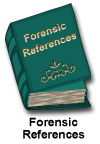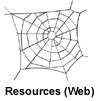|
|
The
required readings for this unit are:
Unit.E.2.2
Forensic ER Physician
 Australia
Australia |
Required
Reading(s)
|
 |
Insert article here
 Canada
Canada |
Required
Reading(s)
|
 |
Insert article here
 International
International |
Required
Reading(s)
|
 |
Insert article here
 United Kingdom
United Kingdom |
Required
Reading(s)
|
 |
Insert article here
 United States
United States |
Required
Reading(s)
|
 |
Insert article here
Databases
For the full text article online,
sleuth the 'University
of Calgary/ Library/ Article Indexes':
Directions:
- Select
- Indexes and abstracts with links to full text articles
- Select
- Academic Search Premier or Expanded Academic ASAP
- Select
- Connect
-
Fill in
User ID and Pin
- Fill
in search words:
forensic and ER Physician and role
Top of Page
|
 |
 |
The
'recommended only' readings for this unit are the following:
Unit.E.2.2
Forensic ER Physician
 Australia
Australia |
Recommended
Reading(s)
|
 |
Insert article/book/chapter here
 Canada
Canada |
Recommended
Reading(s)
|
 |
Insert article/book/chapter here
 International
International |
Recommended
Reading(s)
|
 |
Insert article/book/chapter here
 United Kingdom
United Kingdom |
Recommended
Reading(s)
|
 |
Insert article/book/chapter here
 United States
United States |
Recommended
Reading(s)
|
 |
| Bullock,
K. (2000). Child abuse: The physician's role in |
alleviating
a growing problem. American Family Physician,
61(10), 2977. Retrieved November 13, 2002, from
ProQuest Database.
- Although
the classic battered child who presents with multiple
injuries can be easily identified by the family
physician, it is a diagnostic challenge when no
physical signs are apparent or the child has a single
injury. Bullock discusses the correlation between
domestic abuse and child abuse and suggests ways
in which physicians can screen for abuse.
|
| Challoner,
K. R. (1999). Correctional Medicine. Topics in |
Emergency
Medicine, 21(3), 49- 54. Retrieved December
24, 2002, from http://search.epnet.com/direct.asp?an=7106987&db=aph
- Inmates
are a unique patient population. When emergencies
arise or their medical problems exceed the capabilities
of the prison infirmary, inmates are frequently
referred to the local hospital emergency department.
There are many unique aspects of the prison environment
that must be considered when managing these patients.
These patients are high risk from a medicolegal
standpoint, and their medical care and chart should
reflect this reality. Correctional medicine
is an emerging subspecialty area focusing on the
issues related to the care of this patient population
|
|
US
E.2.2.
Hanan, W. H. (1999, Sept 24). William Eckert, 73,
Medical
|
Sleuth
in Major Cases; [Obituary (Obit)], New York Times,
New York, N.Y., Late Edition (East Coast); pg. B.11.
|
|
US
Heyworth,
J. (2001). Forensic Emergency Medicine. (Book
|
review).
British Medical Journal, 323(7313), 638.
Retrieved December 24, 2002 from EpSCO - Academic
Search Premier: http://search.epnet.com/direct.asp?an=5148148&db=aph
- Reviews
the book 'Forensic Emergency Medicine,' edited by
Jonathan S. Olshaker, M. Christin Jackson, and William
S. Smock
|
| Kassinove,
A. &; Mandavia, D.P. (1999). An introduction to
|
the legal
system for emergency physicians. Topics in Emergency
Medicine, 21(2), 1-7
|
Mallon, W. K. & Kassinove, A. (1999). Mandatory
reporting |
laws
and the emergency department. Topics in Emergency
Medicine, 21(3), 63-72.
|
| Rodriguez,
M. A., McLoughlin, E., Nah, G., Campbell, J. C. |
(2000).
Mandatory reporting of domestic violence injuries
to the police: What do emergency department patients
think? JAMA, 286(5), 580-583
|
| Sachs, C.
J., & Rodriguez, M. A. (2000). Should physicians
|
be required
to report domestic violence to the police? Western
Journal of Medicine, 173(4), 225.
|
| Varvaro,
F. F., & Gesmond, S. (1997). ED physician house
|
staff
response to training on domestic violence. Journal
of Emergency Nursing, 23(1), 17-22.
- Objective
About one fourth of physicians report having received
training on domestic violence. The purpose of this
study was to determine the response of the ED house
staff to an educational program on domestic violence
against women. The research questions in this study
were as follows: (1) What training topics did the
house staff rate as most important and relevant
to their practice? (2) What topics did the house
staff rate as most useful to their day-to-day practice?
(3) What were the house staff's attitudes and beliefs
before training? (4) Did the method of training
on domestic violence influence the house staff's
attitudes and beliefs? (5) What were the house staff's
perceptions in terms of sociodemographic variables?
Methods
An exploratory descriptive study with a three-group
pretest and posttest design was used. The sample
consisted of 37 residents, interns, and medical
students assigned to their clinical rotation in
the emergency department in a large urban hospital
trauma center. The age range of the participants
was 25 to 40 years. The instruments used included
Importance of Training Topics for Domestic Violence
Questionnaire (ITTDVQ), Usefulness of Training Topics
for Domestic Violence Questionnaire (UTTDVQ), Inventory
of Beliefs About Wife Beating (IBWB), and the Self-Efficacy
Scale for Battered Women-Professional Version (SESFBW-PV).
- Results
Topics on domestic violence against women that the
house staff rated as most important, relevant, and
most useful in their day-to-day practice were awareness
of the
problem, referral as intervention, documentation
of abuse, and references/resources. Attitudes and
beliefs after training suggested an increased (1)
confidence in the self-efficacy behaviors of women
who are abused by intimate others, (2) need for
the assessment, treatment, and referral for domestic
violence in women who enter the emergency department
with medical problems/injuries, and (3) belief that
help should be given to women who are abused. There
was very little variation in perceptions of the
house staff in terms of age, gender, education,
ethnic origin, or marital status.
- Discussion
The major conclusion of the study was that the house
staff had a positive response to training on violence
against women. Sixty-five percent of the house staff
had noprevious training on domestic violence. Implications
for practice include continuing education and research
on domestic violence training in the emergency department.
(J Emerg Nurs 1997;23:17-22
|
Top of Page
|

|
Additional
references for this unit can be found in 'forensic
references'
of the forensic sourcebooks.
- Sleuth
'forensic reference' database for:
- forensic
ER Physician - role
Top of Page
|

|
Video's
recommended for this unit are:
|
|
Resources
(Video)
|
 |
Insert video
here
Top of Page
|

|
The
required websites to sleuth for this unit are the following:
 Australia
Australia |
Resources
(Web)
|
 |
Insert website here
 Canada
Canada |
Resources
(Web)
|
 |
Insert website here
 International
International |
Resources
(Web)
|
 |
Insert website here
 United Kingdom
United Kingdom |
Resources
(Web)
|
 |
Insert website here
 United States
United States
|
Resources
(Web)
|
 |
Insert article here
Top of Page
|
 |
For
additional websites on this unit, sleuth 'forensic
websites' in the forensic sourcebooks.
- forensic ER
Physician - role
Top of Page
|
 |
|